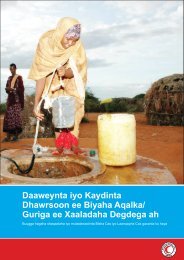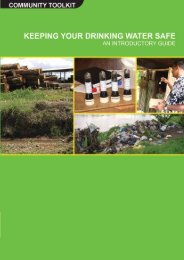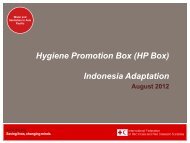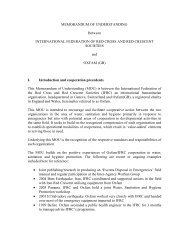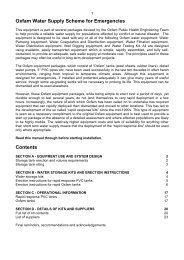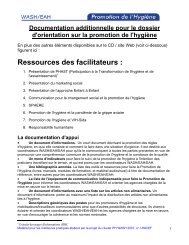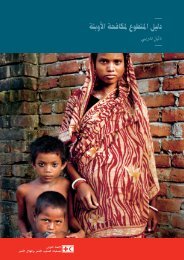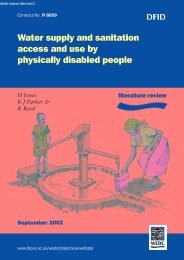Appendix 7. TrachomaSource: http://www.cdc.gov/ncidod/dbmd/diseaseinfo/trachoma_t.htmTrachoma is a chronic eye infection that leads to permanent scars in the conjunctiva <strong>and</strong>cornea. Repeat active infections occur in children < 10 years of age. Subsequently,conjunctival scarring <strong>and</strong> inversion of the eyelashes so they irritate the cornea (trichiasis)develops as a result of earlier infections. Trichiasis predisposes to corneal ulceration <strong>and</strong>corneal opacities resulting in decreased vision <strong>and</strong> blindness. WHO estimates thatapproximately 6 million cases of blindness due to trachoma <strong>and</strong> 11 million cases oftrichiasis occur yearly. Prevalence of active disease in children varies from 10-40% insome African countries to 3-10% in several Asian countries. The overall incidence isunknown.Repeat infections result in a chronic follicular conjunctivitis that leads to scarring in theconjunctiva <strong>and</strong> cornea. Ultimately, corneal opacification <strong>and</strong> blindnessoccurs.Transmission:Primary: person-to-person transmission by ocular <strong>and</strong> respiratory secretions.Secondary: insect vectors such as house flies. Active infection occurs in children < 10years, reinfection during childhood is common. Endemic disease is found in rural areaswith limited economic means <strong>and</strong> poor sanitation <strong>and</strong> water supplies.Trends: unknown. WHO has initiated a global campaign for the elimination of blindnessdue to trachoma, GET2020, that recommends a strategy including antibiotics, improvedpersonal <strong>and</strong> community hygiene <strong>and</strong> sanitation, <strong>and</strong> surgery to correct trichiasis.Campaign challenges include: establishing surveillance for endemic trachoma, determiningwhen mass treatment with antibiotics is necessary (i.e., retreatment), determining theeffectiveness of improved hygiene <strong>and</strong> sanitation at preventing a resurgence of endemicdisease, monitoring for adverse effects of mass treatment with antibiotics, <strong>and</strong> improvingsurgical outcomes. Additional challenges include: improving diagnosis of active disease,monitoring the emergence of antibiotic resistant C. trachomatis, <strong>and</strong> improving ourunderst<strong>and</strong>ing of the transmission <strong>and</strong> reservoirs of C. trachomatis. This page lastreviewed July 2, 2002Source: US Government, Centers for Disease Control <strong>and</strong> Prevention, National Center forInfectious Diseases, Division of Bacterial <strong>and</strong> Mycotic Diseases.82 <strong>Hygiene</strong> promotion
Appendix 8. Some key objectives for hygiene promotion programmesSafe excreta disposalUsing only safe methods of human excreta disposal protects the quality of surface water. Itreduces water treatment costs. Most importantly, it prevents the spreading of various typesof diarrhoeas <strong>and</strong> worms, typhoid <strong>and</strong> paratyphoid <strong>and</strong> schistosomiasis (also known asbilharzia) <strong>and</strong> Bancroftian filariasis. Impacts depend on degree of universality - to whatextent are safe methods used:• By all people? Practised by the elderly, the adult men <strong>and</strong> women, adolescent girls<strong>and</strong> boys, <strong>and</strong> young children, <strong>and</strong> including safe disposal of babies’ stools, in lower,middle <strong>and</strong> upper class households of any religion/caste/ethnic group?• At all times? During all seasons <strong>and</strong> times of night <strong>and</strong> day?• In all locations? At home, in the field, at school, when travelling?Practising safe excreta disposal is always important. The greatest benefits are, however,for children under five (who run the greatest risks) <strong>and</strong> people in areas that are denselysettled, areas in which children <strong>and</strong> grown-ups often use l<strong>and</strong> <strong>and</strong>/or water sources forurination <strong>and</strong> defecation, <strong>and</strong> areas which have a wet <strong>and</strong> hot climate. Colwell (2001)showed, for example, that cholera epidemics in South America occurred when El Niñobrought higher temperatures. To enhance safe excreta disposal practices, a range offacilities, also called the sanitation ladder, can be promoted to suit different needs <strong>and</strong>dem<strong>and</strong>s (payment capacities). http://www.wsp.org/pdfs/eap_options_ppt.pdfSafe h<strong>and</strong>washingSoiled h<strong>and</strong>s are an important source of transmitting diarrhoeas. There is ample proof thath<strong>and</strong>washing before preparing <strong>and</strong> eating food <strong>and</strong> after defecation <strong>and</strong> cleaning children’sbottoms is an effective preventive habit (Boot & Cairncross, 1993). Benefits of safeh<strong>and</strong>washing habits are universal in all areas <strong>and</strong> with all groups, but children, <strong>and</strong> parents<strong>and</strong> siblings caring for young children are especially important groups. H<strong>and</strong>washing isbest done with soap <strong>and</strong> enough water for rinsing. However, if soap is not available oraffordable, ashes, clean mud or local plants are also possible. If nothing better is available,firm rubbing <strong>and</strong> rinsing under a flow is the best alternative. For a poll on a recentpartnership between the public health sector <strong>and</strong> the private sector (soap manufacturers)to promote h<strong>and</strong>washing with soap http://www.globalh<strong>and</strong>washing.org/Use of safe water sourcesThe scope <strong>and</strong> seriousness of health risks influences the need for campaigns on safewater uses. The (almost) eradication of guinea worm in Rajasthan, India <strong>and</strong> in WestAfrican countries is an example of effective programmes. It could be achieved bycombining (1) protection of water sources, (2) massive education campaigns thatcombined mass approaches with interpersonal contacts, (3) treatment <strong>and</strong> (4) incidencemonitoring (UNICEF, 1999).A recent application is the promotion of safe water source use in arsenic contaminationareas. The programme tests the water of each h<strong>and</strong>pump, paints pumps with safe water<strong>IRC</strong> <strong>International</strong> <strong>Water</strong> <strong>and</strong> <strong>Sanitation</strong> <strong>Centre</strong> 83
- Page 2:
Please note that the TOPs are a web
- Page 7 and 8:
1. Hygiene PromotionWhat do you kno
- Page 9 and 10:
2. Why hygiene promotion matters2.1
- Page 11 and 12:
• The costs of inaction can be hi
- Page 13 and 14:
3. Learning from experiences and re
- Page 15 and 16:
• Hygiene Improvement Framework (
- Page 17 and 18:
groups, and facilitators of partici
- Page 19 and 20:
The diagrams are taken from McKee
- Page 21 and 22:
• Food, utensils and food prepara
- Page 23 and 24:
Guides for developing hygiene promo
- Page 25 and 26:
• What may prevent this change in
- Page 27 and 28:
areas, slabs and sanplats for latri
- Page 29 and 30:
often not taken seriously and their
- Page 31 and 32:
IIIIIIIVVInputsProcOutpEffectiImpae
- Page 33 and 34: over for reasons of hierarchy, e.g.
- Page 35 and 36: 5. Case studiesOn the following pag
- Page 37 and 38: The Project recognises the importan
- Page 39 and 40: almost all cases been exceeded, as
- Page 41 and 42: skin diseases, HIV/AIDS and tubercu
- Page 43 and 44: understanding of the importance of
- Page 45 and 46: councils (JSCs) are associations of
- Page 47 and 48: o through a schools programme, with
- Page 49 and 50: outputs and outcomes are focused mo
- Page 51 and 52: Harvey, Eric, Shadrack Dau, Alana P
- Page 53 and 54: programmes more effective. The obje
- Page 55 and 56: scale. Comparison is on approach, l
- Page 57 and 58: Hygiene Behaviour Network, in Globa
- Page 59 and 60: WHO - World Health Organizationhttp
- Page 61 and 62: Tel: (703) 247-8730Fax: (703) 243-9
- Page 63 and 64: Manila, PhilippinesTel: +632 911-57
- Page 65 and 66: TOP Courses and conferencesCREPA, B
- Page 67 and 68: TOP ReferencesBoot, Marieke T. and
- Page 69 and 70: TOP Quiz on Hygiene PromotionTry it
- Page 71 and 72: Question 4All the interventions wil
- Page 73 and 74: Then you may decide that this paper
- Page 75 and 76: Appendix 1. Hygiene promotion manua
- Page 77 and 78: 2. Target specific audiences.These
- Page 79 and 80: Appendix 4. WASH facts and figures1
- Page 81 and 82: Research)18: (IHE Newsletter, Janua
- Page 83: Appendix 6. Preventive measuresMeas
- Page 87 and 88: Appendix 9. Participatory tools and
- Page 89 and 90: Appendix 10. The PHAST approachFor
- Page 91 and 92: Planning techniques are used to sim
- Page 93 and 94: While sensitive topics are often be
- Page 95: About IRCIRC facilitates the sharin



